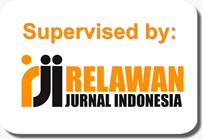ORGANIZATIONAL CULTURE MAPPING USING ORGANIZATIONAL CULTURE ASSESSMENT INSTRUMENT (OCAI) AT PT NEW RATNA MOTOR (NASMOCO) SEMARANG
Abstract
Full Text:
PDFReferences
Arikunto, S. (2006). Prosedur penelitian suatu pendekatan praktik. In Jakarta: Rineka Cipta.
Dickinson, J. E., & Robbins, D. (2008). Representations of tourism transport problems in a rural destination. Tourism Management. https://doi.org/10.1016/j.tourman.2008.02.003
Jayani, D. H. (2019). ini-merek-mobil-terlaris-di-indonesia-2019 @ databoks.katadata.co.id.
Koster, A., Kuhnert, F., & Stürmer, C. (2018). Five trends transforming the Automotive Industry. PwC, 1(1), 35–45.
Kusuma, J. M. (2012). Analisis Pengaruh Budaya Organisasi Dan Komitmen Organisasi Terhadap Kepuasan Kerja Karyawan Pada PT. Bank Mega TBK Cabang Palembang. Sekolah Tinggi Ilmu Ekonomi Musi.
Meyer, P. (2017). toyota-organizational-culture-characteristics-analysis @ panmore.com.
Nie, Y. (Marco), & Wu, X. (2009). Shortest path problem considering on-time arrival probability. Transportation Research Part B: Methodological. https://doi.org/10.1016/j.trb.2009.01.008
Norman, S. M., Avolio, B. J., & Luthans, F. (2010). The impact of positivity and transparency on trust in leaders and their perceived effectiveness. Leadership Quarterly. https://doi.org/10.1016/j.leaqua.2010.03.002
Palmer, I., Dunford, R., & Akin, G. (2009). Managing organizational change 2nd edition. McGrawHill.
Prihayanto, S. (2012). Analisa Pengaruh Budaya Organisasi dan Motivasi terhadap Kinerja Karyawan pada PT. Telkom Regional IV Jawa Tengah-Daerah Istimewa Yogyakarta. PT Raja Grafindo Persada. Jakarta.
Robbins, S., Judge, T. A., Millett, B., & Boyle, M. (2013). Organisational behaviour. Pearson Higher Education AU.
Robbins, S. P., & Coulter, M. (2015). Principles of management. Translated by Seyyed Mohammad Arabi and Mohammed Ali Hamid Rafiee and Behrouz Asrari Ershad, Fourth Edition, Tehran: Office of Cultural Studies.
Robbins, S. P., & Judge, T. A. (2013). Summary for Policymakers. In Climate Change 2013 - The Physical Science Basis. https://doi.org/10.1017/CBO9781107415324.004
Rukanda, Y. P., & Suharnomo. (2013). Analisis Pemetaan Budaya Organisasi Menggunakan Organizational Culture Assessment Instrument Pada PT. Njonja Meneer. UNDIP: Fakultas Ekonomika dan Bisnis.
Septiadi, A. D. (2016). Komunikasi Badan Kesejahteraan Masjid Jumhuriyah Dalam Meningkatkan Minat Masyarakat Pada Kegiatan Keagamaan (Study BKM Jumhuriyah Kepala Siring). IAIN Curup.
Umartias, M., & Djastuti, I. (2014). Pemetaan Budaya Organisasi Menggunakan Organizational Culture Assessment Instrument (OCAI) Pada PT Kereta Api Indonesia Daerah Operasional 4 Semarang. Diponegoro Journal Of Management.
Wibowo, A. (2016). Mencegah dan Menanggulangi Plagiarisme di Dunia Pendidikan. Kesmas: National Public Health Journal. https://doi.org/10.21109/kesmas.v6i5.84
Wibowo, S. (2012). Manajemen Kinerja–Edisi ketiga,. Jakarta: PT Raja Grafindo Persada.
Widodo, & Nuhayatie, T. (2018). The development model of exploitability knowledge based on entrepreneurial learning to innovative performance and sustainable competitive advantage. International Journal of Innovation, Creativity and Change.
Wirawan, Rachman, S., Pratomo, I., & Mita, N. (2008). Design of low cost wireless sensor networks-based environmental monitoring system for developing country. Communications, 2008. APCC 2008. 14th Asia-Pacific Conference on.
Young, B. (2015). 51db6e5aa8210e05e5720ae76cea0837fee3a0df @ nfhsraiderwire.com.
Yu, T., & Wu, N. (2009). A review of study on the competing values framework. International journal of business and management, 4(7), 37–42.
DOI: https://doi.org/10.31846/jae.v11i3.676
Refbacks
- There are currently no refbacks.

This work is licensed under a Creative Commons Attribution-NonCommercial-NoDerivatives 4.0 International License.
e-Jurnal Apresiasi Ekonnomi Indexed by:












